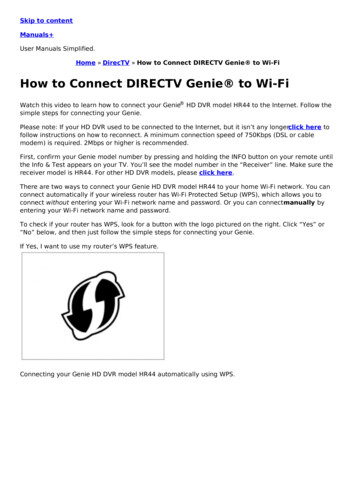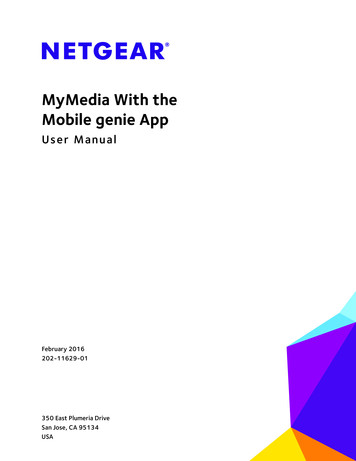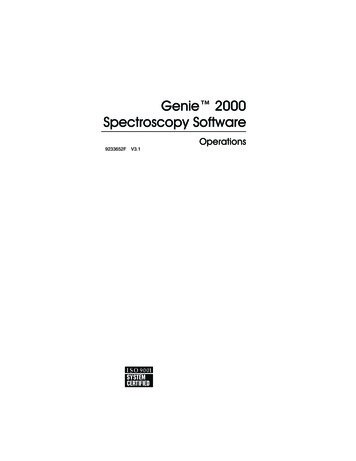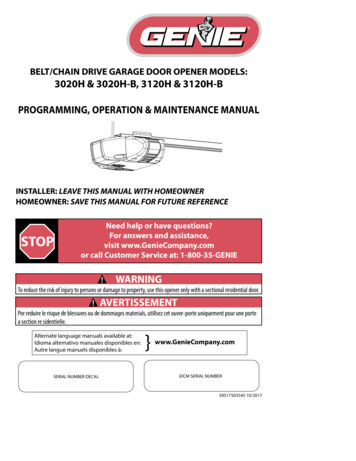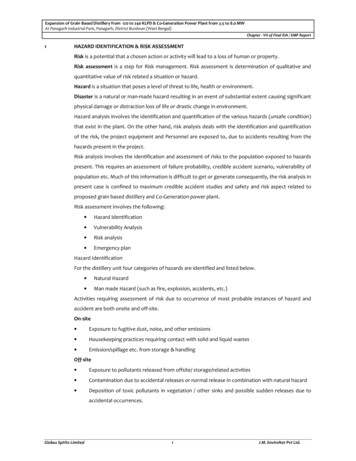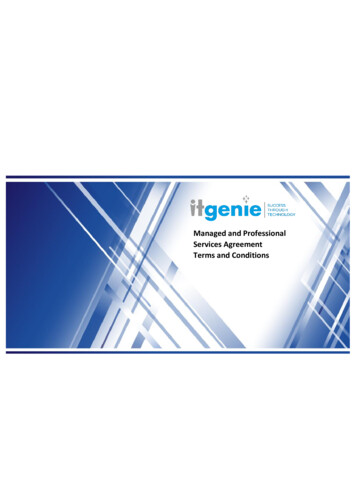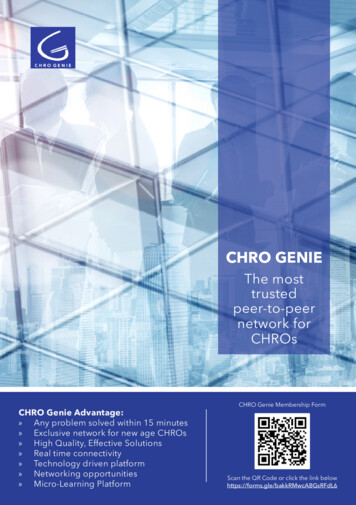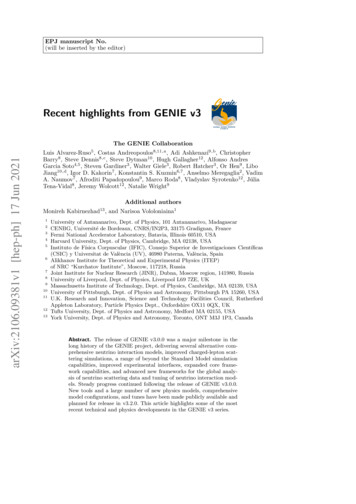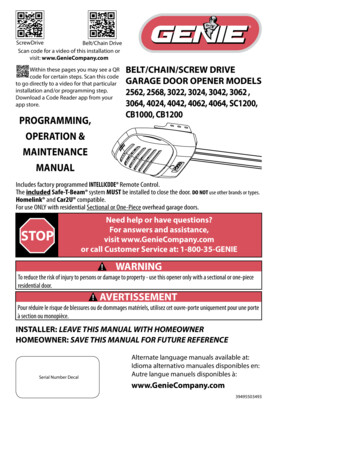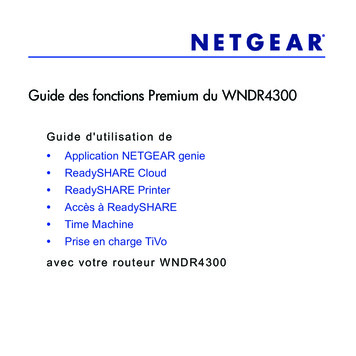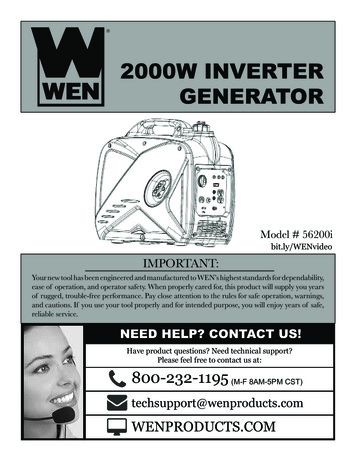
Transcription
Risk and Hazard ManagementModelsGS1330SafeWorkingGS1330Load 50GS4655350MaximumPlatformDrive Height(m)Indoor 3.9Outdoor 3.2Indoor 4.3Outdoor 3.95Outdoor 6.55MaximumWorkingHeight (m)Indoor 5.9Outdoor 5.2Indoor 6.3Outdoor r15.95Outdoor 8.55ContentsIntroduction/Scope.1Hazard Control Measures .4Product Safety .7Introduction/ScopeIn accordance with the relevant Occupational Health and Safety Legislation for the region you are working in (reference tostate legislation is listed below), this report serves as confirmation that each model type Genie scissor, referenced above,has undergone a risk assessment and conforms to the applicable market standard (i.e. AS 1418.10). This risk assessmentinvestigates the potential hazards associated with operation, maintenance, servicing, inspection, transportation and storageof the above referenced plants.Our aim is to help ensure people at work (and any other personnel) are protected against health and safety risks associatedwith the use of the plant detailed within this report. Possible hazards and risks are to be assessed with respect to the useof the plant, on any jobsite, and control measures need to be incorporated, prior to the plants use, to maximise safety. Foreach identified risk, the designed control measures have been implemented to reduce these risks as far as practicable. Anyresidual risks, and their required control measures, can be found on the plant safety decals and in the operators, serviceand safety manuals.GTD 4000 AC27/05/22 Review Date 27/05/2023Page 1 of 7
Each model type receives a Certificate of Test and Compliance, through a third party consulting firm, that confirms theconformity to the applicable standard. Both of these documents can be provided to the owner/user at their request.In accordance with the listed legislation, the information required to be supplied to the Purchaser, or User, of the plant bythe designer, manufacturer, supplier and importer can be found in the operators and service manuals.The listed legislation provides information, for employees, employers, plant installers etc., regarding providing a safeworking environment. To assist in this effort, Genie also provides both operators and service manuals for their productswhich provides information regarding residual risks and their control measures. In addition to these manuals there may beindustry safe use standards for the products that can also be used to help with identifying potential hazards on the jobsite(e.g. AS 2550.10).Hazard Type ChecklistThe table below provides a summary of some potential hazards associated with the use of the plant. Genie evaluates eachof these potential hazards during the risk assessment process in an effort to select specific control measures, (e.g. designs,guarding, warnings) that will reduce the likelihood that the operator, platform occupants, maintenance personnel orbystanders will be exposed to the hazard.Many of these hazards can be identified in the relevant States Plant Hazard Guidance document, and AS1418.10 AppendixA, which is the governing design standard for these plant. CRUSHING,ENTANGLEMENT,CUTTING, ACT, TRAPPING ERGONOMIC,SLIPPING,TRIPPING,FALLINGGTD 4000 ACTable 1Hazard Type ChecklistCan anyone’s hair, clothing, gloves, cleaning apparatus or any other materials become entangled inmoving parts, or objects in motion.Can anyone be crushed due to:o material falling from planto uncontrolled motion or unexpected movement of planto the plant tipping or rolling overo inadequate slowing or stopping devices of plant to control movemento support structure collapseo being thrown from or under the planto coming in contact with moving parts of the plant during testing, inspection, operation,maintenance, cleaning or repairo being trapped between the plant and materials or fixed structuresCutting, stabbing & puncturing due to:o contact with sharp or flying objectso coming in contact with moving parts of the plant during testing, inspection, operation,maintenance, cleaning or repair of the planto parts of plant or worksite material disintegrating or fallingo movement of planto can anyone’s body parts be sheared between moving parts or surfaces of the planto can anyone be burnt due to contact with moving parts or surfaces of the planto can anyone be struck by moving objects due to uncontrolled or unexpected movement ofplant or work pieces (i.e. failure of the control system)Can anyone be injured due to:o uneven or slippery work surfaceso poor housekeeping in the vicinity of or in the planto obstacles being placed in the vicinity of the planto due to repetitive body movementso constrained body posture or the need for excessive efforto design inefficiency causing mental or psychological stresso inadequate or poorly placed lighting of plant or workers IN THE WORKING AREAo lack of failsafe measures against human error or human behaviour27/05/22 Review Date 27/05/2023Page 2 of 7
ooooHIGH OCATION RE MAINTENANCETRANSPORTOCCUPATIONALHAZARDSGTD 4000 AC mismatch of plant with natural human limitationsunhealthy posture or excessive effortslack of personal fall protective equipmentinadequate design/positioning of controlsTable 1Hazard Type ChecklistCan anyone come into contact with fluids under high pressure, due to plant failure or misuse.Can anyone come into contact with objects at high temperatures, or objects which can cause fire orburning.Can anyone suffer illness due to exposure to high or low temperatures.Can anyone be injured by explosion of gases, vapours, liquids, dusts or other substances triggeredby the operation of the plant or material handled by the plant.Can anyone be suffocated due to lack of oxygen, or atmospheric contamination.Can anyone be injured by due to:o the plant coming into contact with live conductorso plant being too close to high tension power lineso overload of electrical circuitso damaged or poorly maintained electrical leads and cableso damaged electrical switcheso water near electrical equipmento lack of insulation against water contact shortingo thermal radiationo electrostatic radiationo magnetic interference from workplace affecting electrical componentsCan machine tip or roll over due to stability system not extending.Stability system failing structurally, mechanically, or retract unintentionally.Control valve or interlock failure.Setting up on soft ground, unlevel or uneven ground, excessive slope.Driving on rough surfaces, over potholes, hitting fixed objects, excessive side loads, operation inexcessive climatic conditions e.g. wind.Uneven SWL weight distribution in the platform.Hydraulic system failure.Check valve or relief valve failure.Hose or cylinder failure - mechanical or fatigue.Structural failure due to fatigue, corrosion, or overloading.Pin, cable or linkage failure.General overload, lifting excessive load, loading platform/ basket in an unintended way.Can anyone be injured:o while carrying out routine, preventative or corrective maintenance.o explosi
Risk and Hazard Management . Models GS1330 Safe Working . Load (kg) 227 Maximum Platform . Drive Height . Many of these hazards can be identified in the relevant States Plant Hazard Guidance document, and AS1418.10 Appendix A, which is the governing design standard for these plant. . o parts of plant or worksite material disintegrating or .
